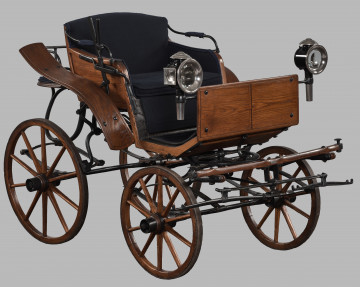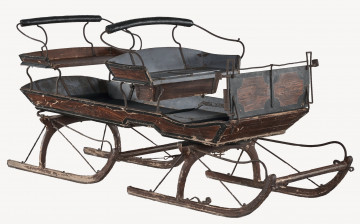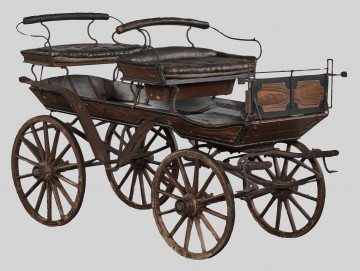
Ziegewagen
19th / 20th century
Castle Museum in Łańcut
Part of the collection: Pojazdy i uprzęże
A hearse is a ceremonial vehicle of a funeral character in which the coffin is carried during the burial ceremony. In the second half of the 19th century hearses had various forms of body, ranging from vehicles having only a supported canopy to closed and glazed ones. It was used with two- or four-horse teams, the horses wearing black caps or long hoods, which also covered their heads. The hearse described here, purchased by the Castle Museum in Łańcut for its Museum Vehicle Collection, is one of three such vehicles in the collection. It is the largest and most parade one among them. It comes from Łódź, where it was most probably used (searches have revealed several more very similar ones that have survived in Poland). It is signed by the blacksmith’s workshop of G. Ewest, who certainly made the chassis and the very impressive body decoration. The hearse described has a glazed rectangular wooden body decorated with very rich relief decoration, topped with an openwork, richly carved crest at the corners, with full-figured figures of kneeling angels, and in the middle of the roof a cross supported on a sphere with figures of two more angels adoring it. At each upper corner of the body there is a volute rolled stylised flowering floral weave with handle and a hexagonal candle lantern. Similar spirals, in the form of stylised very rich flowering plant weaves, are placed on the sides of the rear wall, which is opened upwards. Inside the glazed body are low nickel-plated metal barriers to stabilise the coffin, which is pulled out by a wooden rectangular base with four rollers at the corners, sliding on two longitudinal grooves in the base and on a central metal rail. A trapezoidal coachman seat in the form of a rigid shabrack, on forged iron bent S-shaped supports with a narrow wooden footstool. At the sides of the coachman seat, there are short nickel-plated handles, while the seat is equipped with a handrail-backrest. The hearse is painted in opaque black varnish, while the relief and body parts are black and gold. It was used in the films The Promised Land by A. Wajda and Vabank II by J. Machulski. Aldona Cholewianka-Kruszyńska
Other names
Hearse
Author / creator
Object type
Vehicles and harnesses
Technique
installation
Material
glass, wood, metal
Origin / acquisition method
zakup
Creation time / dating
Creation / finding place
Owner
Castle Museum in Łańcut
Identification number
Location / status

19th / 20th century
Castle Museum in Łańcut

20th century
Castle Museum in Łańcut

20th century
Castle Museum in Łańcut
DISCOVER this TOPIC
Museum of King Jan III's Palace at Wilanów
DISCOVER this PATH
Educational path